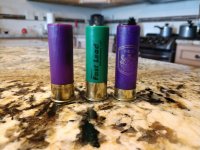Great shells, speed kills.
Bilbo -- You're free to shoot what you like or what the marketing folks tell you, but here is some info that I've posted before comparing Federal High-Velocity loads against their normal-velocity loads and some heavier Winchester loads.
Hope this helps, good Luck!
Are you really getting any benefits from the more expensive “Premium” or “Super” pheasant loads on the market?
Well, let’s see what the pattern board can tell us about some of these loads and how they perform in my gun and chokes.
Patterning results from a 12-gauge Browning Citori with 28" Invector-plus barrels using Briley flush chokes (patterns average of five, 30" post-shot scribed circle, yardage taped muzzle to target, and in-shell pellet count average of five).
12 GA 2 3/4" FEDERAL GAME-SHOK HEAVY FIELD LOAD
1 ¼ oz #5 lead (224 pellets) @ 1220 fps
30 YARDS – IC / pattern 173 (77%)
40 YARDS – Mod / pattern 145 (65%)
50 YARDS – Full / pattern 109 (49%)
12 GA 2 3/4" FEDERAL PREMIUM UPLAND HIGH-VELOCITY LOAD
1 ¼ oz #5 lead (216 pellets) @ 1400 fps
30 YARDS – IC / pattern 152 (70%)
40 YARDS – Mod / pattern 126 (58%)
50 YARDS – Full / pattern 84 (39%)
12 GA 2 3/4" WINCHESTER SUPER PHEASANT LOAD
1 3/8 oz #5 lead (234 pellets) @ 1300 fps
30 YARDS – IC / pattern 186 (79%)
40 YARDS – Mod / pattern 149 (64%)
50 YARDS – Full / pattern 113 (48%)
It’s obvious from the pattern numbers that the Game-Shok load shot tighter patterns (IC / +7%, Mod / +7%, and Full / +10%) than the Premium Upland high-velocity load with the chokes tested.
Now, the Winchester Super Pheasant 1 3/8-ounce load started out with 10 more pellets than the 1 ¼-ounce Game-Shok load; and it did put a few more pellets (IC / +13 pellets, Mod / +4 pellets, and Full / +4 pellets) in the patterns than the Game-Shok load. The question you have to ask yourself is… are those few extra pellets in the 30-, 40- and 50-yard patterns really providing any noticeable benefit to killin’ pheasants?
It’s clear to me that you could save some money and reduce recoil by shooting the relatively slow 1220 fps load and not really forgo any pheasant killin’ effectiveness. Heck, the slower Game -Shok load put 24 more pellets (a 29% increase) in the 50-yard pattern than the Premium Upland load and had only 4 fewer pellets than the heavier Winchester Super Pheasant load. Just because they are labeled “Premium” or “Super” loads, it doesn’t necessarily mean they are “better” at killin’ pheasants!
That’s my take, now you can be the judge!


